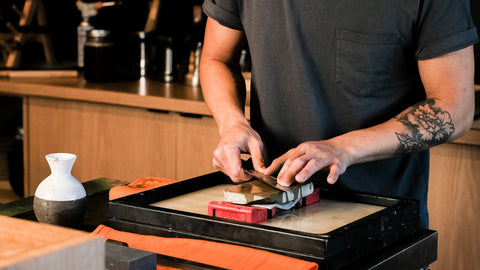Perhaps the most important step when sharpening a knife is to identify the angle for sharpening and it is likely the easiest step in the process. This can often take a bit of tinkering to find the ideal angle for a particular knife but selecting a sharpening angle of 20 degrees is a good starting point for most knives.
The 20 degree angle will produce a good result for most knives. However, if you would like to get the optimal level of performance out of a particular knife, then fine tuning is always recommended.
Selecting the right sharpening angle will always be a balance. For instance, whether the knife is single or double bevel will likely be a factor. However, generally there are 4 ranges that come into consideration.
Under 10 Degrees
When the knife you are using will be performing cuts on softer materials, it may be appropriate to sharpen the knife at the lowest of angles. The benefit of sharpening at such a low angle is so that the edges are not subjected to abuse. This is the type of angle normally found on items such as a straight edge razor. These knives normally are sharpened at an angle between 7 and 8 degrees.
Between 10 - 17 Degrees
This sharpening angle is again quite low for the vast majority of knives. An edge sharpened to this extreme is very effective for a knife that is used for kitchen chopping tasks but must be used carefully. A knife user would normally sharpen to this degree if their knife was being used to cut soft items or for slicing meats. However, if you have a high quality knife made from premium Damascus steel then sharpening to this level can prove highly effective.
Between 17 - 21 Degrees
This angle generally covers the majority of kitchen knives and their uses. Most western knives usually fall within this range and are sharpened at an angle of 20 degrees. Knives sharpened to this level generally cut very well and maintain a high level of durability. While they are considered durable for the majority of kitchen tasks, a knife sharpened to this degree may not respond effectively to hardened materials.
Between 22 - 30 Degrees
A knife sharpened within this range is considered far more durable but is generally only necessary for hobby knives such as a pocket knife or a hunting knife. This is especially the case where the sharpening angle exceeds 25 degrees. While the edge will not generate as effective a cut as the previous angles, it will be considerably more durable in most cases.
In Excess of 30 Degrees
A knife that is sharpened in excess of 30 degrees is considered very durable. With that said, its cutting capability will drastically reduce. This is why most knives, and especially those in your kitchen, will not benefit from such a sharpening angle. It is more likely this kind of angle would be utilized for a machete or axe whose primary purpose is to smash through hard to chop items.
Durability vs Effectiveness - Not always the case
Many think that choosing the sharpening angle of a knife means choosing between durability and sharpening effectiveness. While obviously sharpening at a lower angle will reduce durability in most cases, this is not true where the quality of the knife is significantly great and this is the fundamental reason why our knife selection is so highly rated. The high-grade Damascus steel contained within our knives is what allows our customers to sharpen at a lower angle of approximately 15 degrees. The result is a sharp, durable knife that is ready to accomplish any kitchen task that you throw at it.
